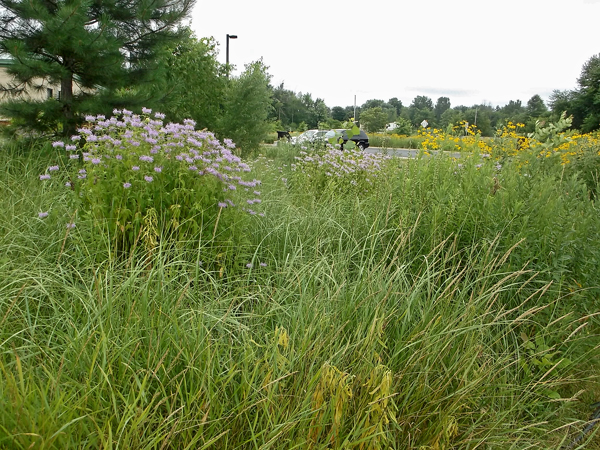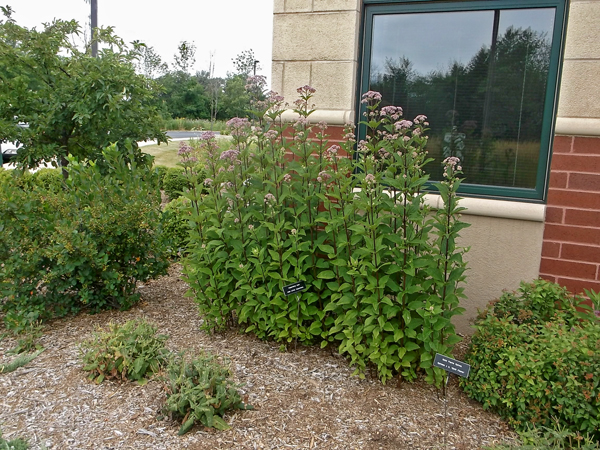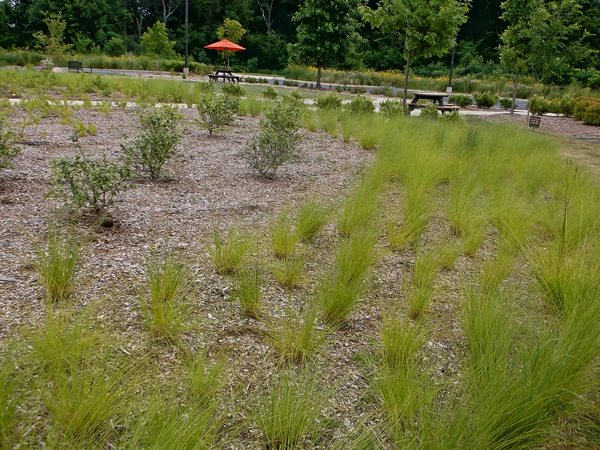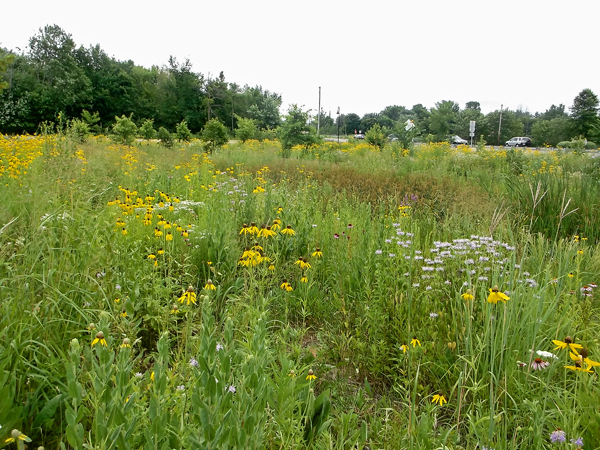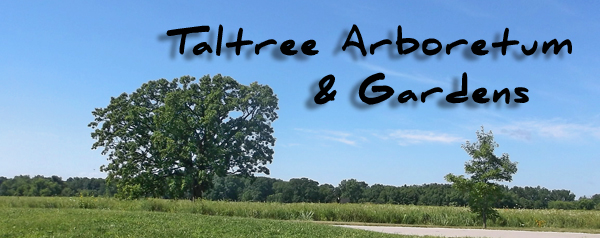At the gateway to the Indiana Dunes National Lakeshore you can find the Dorothy Buell Memorial Visitor Center, located in Porter, Indiana. Used by not only the Indiana Dunes National Lakeshore, but also the Indiana Dunes State Park and the Porter County Convention, Recreation, and Visitor Commision, a visitor can find information on all things Indiana. The visitor center was named for Dorothy Buell (1886-1977), an active proponent in the 1950’s and 60’s for federal protection of the Indiana Dunes. In 1966 President Lyndon Johnson signed the bill that established the national park (reference ).
The landscaping surrounding the visitor center is mostly inspired by the surrounding natural landscape, including a recreated prairie, a rain garden, bio-swales, and landscape beds with a mix of regionally native and exotic species. The landscape architects of record for the project are Williams Creek Consulting, of Indianapolis.
The Rain Garden
The rain garden is located along the west side of the visitor center, facing the street (Indiana 49). This area and other areas were planted with the help of volunteers from Save the Dunes in 2009. The garden is essentially a vegetated ditch (aka. swale, or bio-swale) that collects rainwater runoff from the adjacent parking lots and roof of the building, helping to clean the runoff of pollutants, including suspended sediment, before it enters the nearby creek and ultimately Lake Michigan, as well as allowing some of the runoff to percolate into the sandy soil. A nearby interpretive sign explains the process as well a data sheet that can be found by clicking here.
Some of the plantings seen below in the rain garden, include the pink flowered Beebalm (Monarda fistulosa), White Pine, Willows, as well as dune grasses and Rattlesnake Master (Eryngium yuccifolium) in the upper portions of the plantings.
Landscape Beds
The designed (more formally laid out) landscape beds are a bit hit or miss. The Joe-Pye-Weed pictured above was also mislabeled as an aster, which is unfortunate, since part of this garden’s mission is education. Also the salvia planted in front of it, which has nice blue flowers in June, is native to Europe and Asia; so while very attractive in bloom, Blue Mist Flower, (Conoclinium coelestinum, formally a Epatorium) a native to the Lower Midwest would have been a more appropriate choice for a native plant garden.
 In the bed pictured above someone felt the need for a sign instructing whomever maintains the site, not to mow beyond the plastic edging. I’m not sure that it is needed, but it is a bit discouraging to anyone who might want to try these plants in their own yard .. are they “pretty weeds” or are they appropriate native landscape plants? The Butterfly Milkweed (Asclepias tuberosa) in the foreground has awesome, bright orange, flowers in June and July, but can look a bit tired after blooming, (and does not like to be heavily mulched, as these are – their crowns tend to rot out.) It may have been nice to interplant them with some native grasses, such as Junegrass (Koleria) or Prairie Dropseed (Sporobolis), the fern planted in full sun, next to a brick building may also have been better thought out. The Mountain Laurel shrubs (Kalmia latifolia), an East Coast native, were is bloom during this July visit and seem to be doing well, however.
In the bed pictured above someone felt the need for a sign instructing whomever maintains the site, not to mow beyond the plastic edging. I’m not sure that it is needed, but it is a bit discouraging to anyone who might want to try these plants in their own yard .. are they “pretty weeds” or are they appropriate native landscape plants? The Butterfly Milkweed (Asclepias tuberosa) in the foreground has awesome, bright orange, flowers in June and July, but can look a bit tired after blooming, (and does not like to be heavily mulched, as these are – their crowns tend to rot out.) It may have been nice to interplant them with some native grasses, such as Junegrass (Koleria) or Prairie Dropseed (Sporobolis), the fern planted in full sun, next to a brick building may also have been better thought out. The Mountain Laurel shrubs (Kalmia latifolia), an East Coast native, were is bloom during this July visit and seem to be doing well, however.
The picnic area to the east of the visitor center consists of broad swathes of perennials and shrubs, interplanted with shade trees. The sweep of Prairie Dropseed grass (Sporobolis heterilepis), seen above, seems to be doing quite well, despite the excess of bark mulch covering their crowns – it’s a beautifull and tough prairie native.
In a nearby planting, Chinese Silver Grass (Miscanthus sp.)can be found at the base of a Midwestern Redbud tree (Cercis canadensis). The Midwestern prairie has so many garden worthy grasses, including Switchgrass (Panicum virgatum), that the use of miscanthus seems a bit silly, if not insulting. I won’t even mention the Russian Sage to the left of the miscanthus (yeah, I know, I just did.) The Eastern Redbud, is a great choice in the designed landscape. As a member of the legume family (peas, soybeans, eg.) it is quite adaptable to various soil conditions due to their ability to fix nitrogen from the air through the process of rhizobial symbiosis.
In the same bed, can be found the Asian native, Ural Falsespirea (Sorbaria sorbifolia), next to a European Shasta Daisy. While both plants are very attractive to the viewer (maybe not so attractive to pollinators), the Prairie Winged Sumac (Rhus copallina) and any number of our Midwest wildflowers, I would suggest Yellow Baptisia (Baptisia tinctoria) or Cream Indigo (B. leucophaea), would have been awesome, not to mention … wait for it …… NATIVE! Oh, well. Russian Sage and Ural Falsespirea .. that’s a theme too, I suppose.
Near the delivery bays at the northeast corner (seen below) of the building there is a curious mix of native Fragrant Sumac (Rhus aromatica) along with a magnolia and the shade loving Asian perennial, astilbe.
Some Japanese Deutzia near the front entrance; New Jersey Tea (Ceanothus americanus), a low growing prairie shrub, could have been chosen, and it has much nicer flowers.
 While checking out the Japanese Deutzia, I thought I heard the sound of weeping, kind of a sad wailing, really. I looked around and didn’t see anyone, then I realized, as I got closer, it was coming from the Virgina Sweetspire ‘Little Henry’ (Itea virginica). They are a naturally low growing shrub with a nice fountain-like branching pattern. These Sweetspire, however, where traumatized, sheared into little disfiguring gumdrops – I had to walk away, I felt bad for their predicament, but could do nothing but sympathize.
While checking out the Japanese Deutzia, I thought I heard the sound of weeping, kind of a sad wailing, really. I looked around and didn’t see anyone, then I realized, as I got closer, it was coming from the Virgina Sweetspire ‘Little Henry’ (Itea virginica). They are a naturally low growing shrub with a nice fountain-like branching pattern. These Sweetspire, however, where traumatized, sheared into little disfiguring gumdrops – I had to walk away, I felt bad for their predicament, but could do nothing but sympathize.
Across the way, surrounding the flagpole, was the ubiquitous European ‘Karl Foerster’ Grass – again, like the Chinese Silver Grass, not a bad grass visually, just, well, really? ‘Northwind’ Switchgrass, a prairie nativar similar in growth habit, with blue/green leaves, would have been a splendid choice for this area. Now I was beginning to weep.
Bio-Swale
Wiping a tear from my eye, a smile immediately came to my face. Beyond the wonky ‘Karl Foerster’ Grass, was a recreated prairie – really beautiful. It turns out, it is also a bio-swale and acts as a floodplain for Dunes Creek, which flows through it. An attractive alternative to the standard detention basin.




